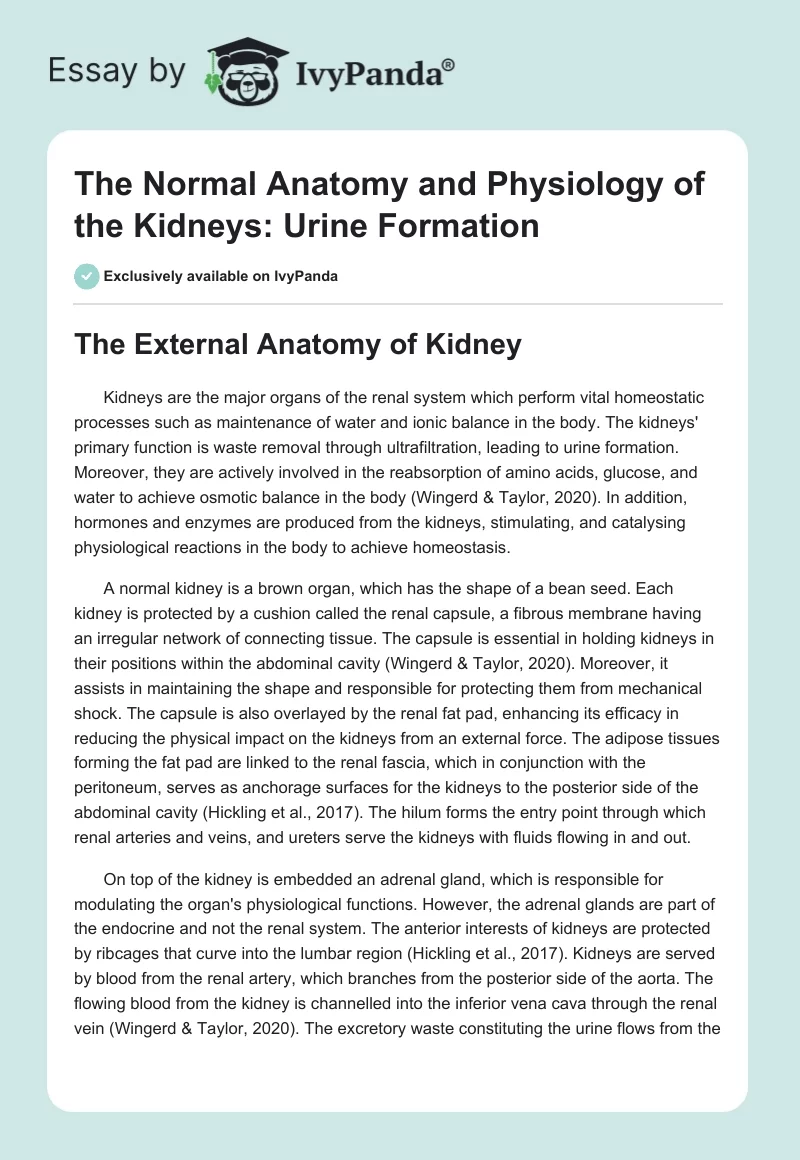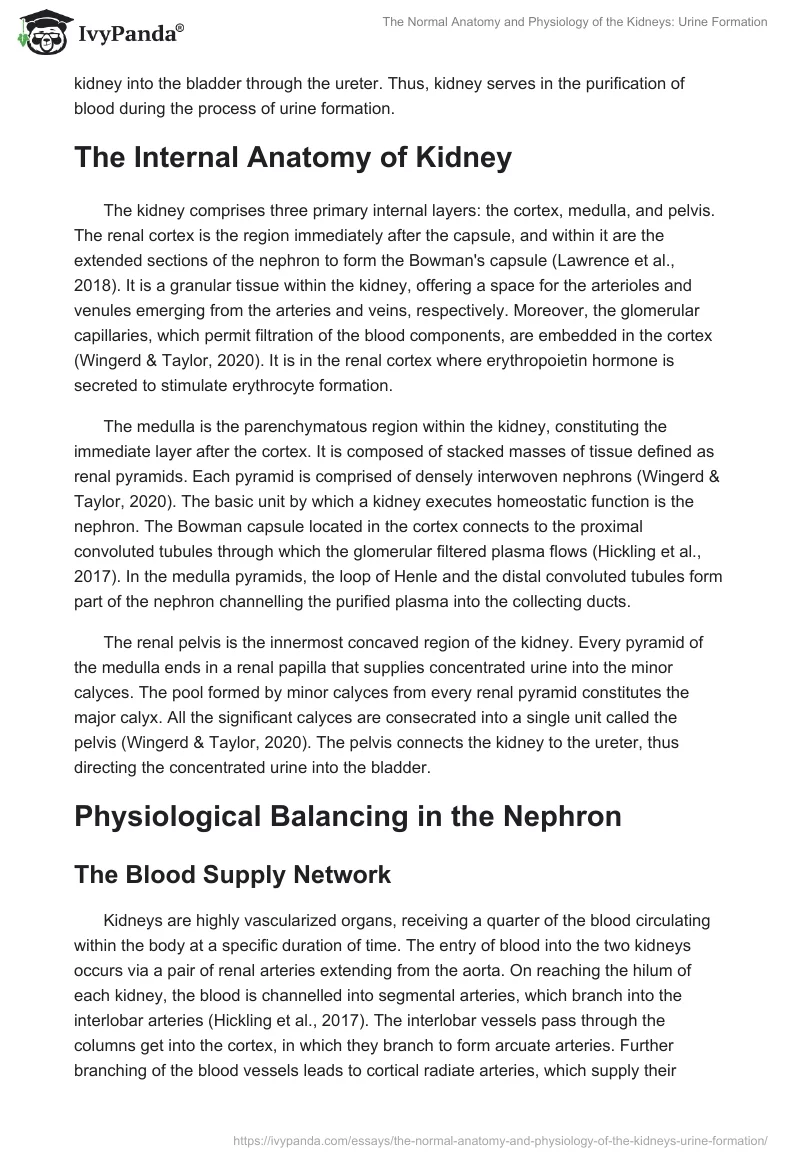The External Anatomy of Kidney
Kidneys are the major organs of the renal system which perform vital homeostatic processes such as maintenance of water and ionic balance in the body. The kidneys’ primary function is waste removal through ultrafiltration, leading to urine formation. Moreover, they are actively involved in the reabsorption of amino acids, glucose, and water to achieve osmotic balance in the body (Wingerd & Taylor, 2020). In addition, hormones and enzymes are produced from the kidneys, stimulating, and catalysing physiological reactions in the body to achieve homeostasis.
A normal kidney is a brown organ, which has the shape of a bean seed. Each kidney is protected by a cushion called the renal capsule, a fibrous membrane having an irregular network of connecting tissue. The capsule is essential in holding kidneys in their positions within the abdominal cavity (Wingerd & Taylor, 2020). Moreover, it assists in maintaining the shape and responsible for protecting them from mechanical shock. The capsule is also overlayed by the renal fat pad, enhancing its efficacy in reducing the physical impact on the kidneys from an external force. The adipose tissues forming the fat pad are linked to the renal fascia, which in conjunction with the peritoneum, serves as anchorage surfaces for the kidneys to the posterior side of the abdominal cavity (Hickling et al., 2017). The hilum forms the entry point through which renal arteries and veins, and ureters serve the kidneys with fluids flowing in and out.
On top of the kidney is embedded an adrenal gland, which is responsible for modulating the organ’s physiological functions. However, the adrenal glands are part of the endocrine and not the renal system. The anterior interests of kidneys are protected by ribcages that curve into the lumbar region (Hickling et al., 2017). Kidneys are served by blood from the renal artery, which branches from the posterior side of the aorta. The flowing blood from the kidney is channelled into the inferior vena cava through the renal vein (Wingerd & Taylor, 2020). The excretory waste constituting the urine flows from the kidney into the bladder through the ureter. Thus, kidney serves in the purification of blood during the process of urine formation.
The Internal Anatomy of Kidney
The kidney comprises three primary internal layers: the cortex, medulla, and pelvis. The renal cortex is the region immediately after the capsule, and within it are the extended sections of the nephron to form the Bowman’s capsule (Lawrence et al., 2018). It is a granular tissue within the kidney, offering a space for the arterioles and venules emerging from the arteries and veins, respectively. Moreover, the glomerular capillaries, which permit filtration of the blood components, are embedded in the cortex (Wingerd & Taylor, 2020). It is in the renal cortex where erythropoietin hormone is secreted to stimulate erythrocyte formation.
The medulla is the parenchymatous region within the kidney, constituting the immediate layer after the cortex. It is composed of stacked masses of tissue defined as renal pyramids. Each pyramid is comprised of densely interwoven nephrons (Wingerd & Taylor, 2020). The basic unit by which a kidney executes homeostatic function is the nephron. The Bowman capsule located in the cortex connects to the proximal convoluted tubules through which the glomerular filtered plasma flows (Hickling et al., 2017). In the medulla pyramids, the loop of Henle and the distal convoluted tubules form part of the nephron channelling the purified plasma into the collecting ducts.
The renal pelvis is the innermost concaved region of the kidney. Every pyramid of the medulla ends in a renal papilla that supplies concentrated urine into the minor calyces. The pool formed by minor calyces from every renal pyramid constitutes the major calyx. All the significant calyces are consecrated into a single unit called the pelvis (Wingerd & Taylor, 2020). The pelvis connects the kidney to the ureter, thus directing the concentrated urine into the bladder.
Physiological Balancing in the Nephron
The Blood Supply Network
Kidneys are highly vascularized organs, receiving a quarter of the blood circulating within the body at a specific duration of time. The entry of blood into the two kidneys occurs via a pair of renal arteries extending from the aorta. On reaching the hilum of each kidney, the blood is channelled into segmental arteries, which branch into the interlobar arteries (Hickling et al., 2017). The interlobar vessels pass through the columns get into the cortex, in which they branch to form arcuate arteries. Further branching of the blood vessels leads to cortical radiate arteries, which supply their contents into the arterioles. Blood from the arterioles enters the glomerulus via the afferent arteriole. After glomerular filtration, the blood leaves the network of capillaries via the efferent arteriole (McDonald, 2019). Moreover, a portal of blood vessels extends from the afferent and efferent arterioles surrounding the proximal convoluted tubules, the loop of Henle, and the distal convoluted tubule to aid the urine concentration process.
Ultrafiltration in the Glomerulus
The formation of urine begins with the filtration process, which takes place in the glomerulus, a mesh of capillaries connected to the Bowman’s capsule. Ultrafiltration in the glomerulus does not require energy. However, it is accomplished through pressure build-up, which pushes the plasma and solute particles through the capillary walls. The process of filtration is aided through a three-layered membrane system (Lawrence et al., 2018). The fenestrated endothelia of capillaries in the permits plasma to pass through them, and not blood cells. Immediately, the negatively charged basement membrane blocks proteins from passing. Finally, the capsule of the capsule in the glomeruli develops a barrier that allows for the selected particles’ filtration. The efficiency of the filtration process is determined by the pressure create by the cardiac pumps of blood through the aorta, arteries, arterioles, and capillaries (Hickling et al., 2017). The net force for filtration generated in the glomeruli yields the glomerular filtrate channelled into the proximal convoluted tubule via the Bowman’s capsule.
Urine Concentration through Water and Ion Re-absorption
The kidney nephron is characterized by four tubular components in which reabsorption of water, ions, amino acids, and glucose takes place. The proximal convoluted tubule is attributed to the highest capacity of absorbing elements of the glomerular filtrate. From its lumen, sodium ions are taken back to the bloodstream by an active transport mechanism involving basolateral pumping of sodium-potassium ions (Lawrence et al., 2018). The secondary dynamic transport mechanism is involved in the reabsorption of amino acids, glucose, and vitamins. Moreover, water is reabsorbed by osmosis created by the ionic imbalance, which in turn drives the diffusion of lipids across the wall of proximal convoluted tubule into the bloodstream (Gupta & Sharma, 2020). The reabsorption of ions, sugar, amino acids, and lipids is essential in osmoregulation all over the body.
The glomerular filtrate moves into the loop of Henle, having the ascending and descending sections. The reabsorption of water through osmosis into the bloodstream main occurs in the descending spiral. On the other hand, potassium, sodium, and chloride ions are taken back to the bloodstream via the ascending loop of Henle (McDonald, 2019). The ATPase enzyme drives the process by creating an ionic gradient which makes the basolateral membrane of the symporter in the ascending loop to be functional in absorbing ions. Immediately after the loop of Henle, the filtrate enters the distal convoluted tubule where sodium ion absorption occurs. Mainly, active transport is involved in sodium-ion uptake via basolateral membrane (Lawrence et al., 2018). However, its passive absorption into the bloodstream occurs through sodium and chloride ion symporter on the apical plasmalemma. In the distal convoluted tubule, aldosterone hormone regulates sodium ion intake while parathyroid hormone controls the reabsorption of calcium ion (McDonald, 2019). Eventually, concentrated urine remaining in the lumen of the tubules moves into the collecting ducts, where final reabsorption occurs via active transport.
Conclusion
The concentrated urine is channelled into the pelvis; after that, it travels to the urinary bladder via the ureter. The kidney has two major homeostatic roles in the body, that is, maintenance of pH through balancing hydrogen ion concentration and osmoregulation. Moreover, it aids the purification of the blood by removing excess water, salts, and impurities. Its physiological functions encompass energy and the regulated hormonal process leading to the reabsorption of ions into the bloodstream. Thus, the structural and physiological function of the kidney allows urine formation and purification of blood.
References
Gupta, R., & Sharma, T. (2020). Review of urine formation in Ayurveda. Journal of Ayurveda and Integrated Medical Sciences, 5(1), 145-148.
Hickling, D. R., Sun, T. T., & Wu, X. R. (2017). Anatomy and physiology of the urinary tract: relation to host defence and microbial infection. In Urinary Tract Infections: Molecular Pathogenesis and Clinical Management (pp. 1-25).
Lawrence, E. A., Doherty, D., & Dhanda, R. (2018). Function of the nephron and the formation of urine. Anaesthesia and Intensive Care Medicine, 19(5), 249-253.
McDonald, M. D. (2019). The renal contribution to salt and water balance. In Fish Osmoregulation (pp. 309-331). CRC Press.
Wingerd, B., & Taylor, T. B. (2020). The Human Body: Concepts of Anatomy and Physiology. Jones & Bartlett Learning.


